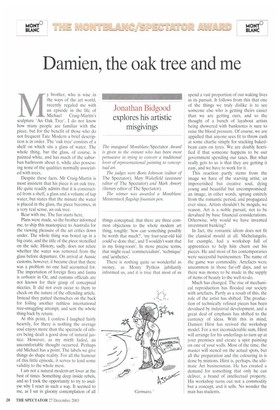Damien, the oak tree and me
11111111111111111111
Jonathan Bidgood explores his artistic misgivings
My brother, who is wise in the ways of the art world, recently regaled me with an episode in the life of
Michael Craig-Martin's sculpture 'An Oak Tree'. I do not know how many people are familiar with the piece, but for the benefit of those who do not frequent Tate Modern a brief description is in order. The 'oak tree' consists of a shelf on which sits a glass of water. The whole thing, bar the glass, of course, is painted white, and has much of the suburban bathroom about it. while also possessing none of the qualities normally associated with trees.
Despite these facts, Mr Craig-Martin is most insistent that his piece is an oak tree. He quite readily admits that it is constructed from a shelf, a glass and a volume of tap water, but states that the minute the water is placed in the glass, the piece becomes, in a very real sense, an oak tree.
Bear with me. The fun starts here.
Plans were made, so the brother informed me, to ship this masterpiece to Australia for the viewing pleasure of the art critics down under. The whole thing was boxed up in a big crate, and the title of the piece stencilled on the side. History, sadly, does not relate whether the water was removed from the glass before departure. On arrival at Aussie customs, however, it became clear that there was a problem no one had accounted for. The importation of foreign flora and fauna is verboten in Oz, and customs officials are not known for their grasp of conceptual niceties. It did not even occur to them to check on the nature of the offending article. Instead they patted themselves on the back for foiling another ruthless international tree-smuggling attempt, and sent the whole thing back by return.
At this point, I confess I laughed fairly heartily, for there is nothing the average soul enjoys more than the spectacle of others being dealt a good dose of natural justice. However, as my mirth faded, an uncomfortable thought occurred. Perhaps old Michael has a point. The labels we give things do shape reality. For all the humour of this little episode, it serves to lend some validity to the whole mess.
I am not a natural modern-art lover at the best of times. Something deep inside rebels, and so I took the opportunity to try to analyse why I react in such a way. It seemed to me, as I sat in gloomy contemplation of all The inaugural Montblanc1Spectator Award is given to the entrant who has been most persuasive in trying to convert a traditional lover of representational painting to conceptual art.
The judges were Boris Johnson (editor of The Spectator), Mary Wakefield (assistant editor of The Spectator) and Mark Amory (literary editor of The Spectator).
The winner was awarded a Montblanc Meisterstuck flagship fountain pen.
things conceptual, that there are three common objections to the whole modern art thing, roughly: 'how can something possibly be worth that much?', 'my four-year-old kid could've done that', and 'I wouldn't want that in my living-room'. In more precise terms, that might read 'commercialism', 'technique' and 'aesthetics'.
There is nothing quite so wonderful as money, as Monty Python jubilantly informed us, and it is true that most of us spend a vast proportion of our waking lives in its pursuit. It follows from this that one of the things we truly dislike is to see someone else who is getting theirs easier than we are getting ours, and so the thought of a bunch of layabout artists being showered with banknotes is sure to raise the blood pressure. Of course, we are appalled that anyone sees fit to throw cash at some charlie simply for stacking bakedbean cans on tyres. We are doubly horrified if that someone happens to be our government spending our taxes. But what really gets to us is that they are getting it easy, and we have to work for it.
This reaction partly stems from the image we have of the starving artist, an impoverished but creative soul, dying young and beautiful but uncompromisecl: an image, in other words, sprung entirely from the romantic period, and propagated ever since. Artists shouldn't be moguls, we reason. Art is a noble pursuit, not to be devalued by base financial considerations. Otherwise, why would we have invented investment banking?
In fact, the romantic idiom does not fit the classical mould at all. Michelangelo, for example, had a workshop full of apprentices to help him churn out his pieces. He and most of his contemporaries were successful businessmen. The name of the game was commodity. Artefacts were uncommon in those far-off days, and so there was money to be made in the supply of items of beauty to the well-to-do.
Much has changed. The rise of mechanical reproduction has flooded our society with artefacts. Partly as a result of this, the role of the artist has shifted. The production of technically refined pieces has been devalued by industrial development, and a great deal of emphasis has shifted to the currency of ideas. With this in mind, Damien Hirst has revived the workshop model. For a not inconsiderable sum, Hirst will arrange for his underlings to turn up at your premises and create a spot painting on one of your walls. Most of the time, the master will stencil on the actual spots, but all the preparation and the colouring in is done by minions. Hirst is, perhaps. the ultimate Art businessman. He has created a demand for something that only he can deliver, a brand of intellectual property. His workshop turns out not a commodity but a concept, and it sells. No wonder the man has students.


























































 Previous page
Previous page